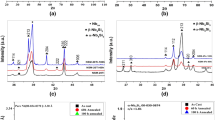Abstract
In this work, the Nb-rich ternary eutectic in the Nb-Si-Cr system has been experimentally determined to be Nb-10.9Si-28.4Cr (in at. pct). The eutectic is composed of three main phases: Nb solid solution (Nbss), β-Cr2Nb, and Nb9(Si,Cr)5. The ternary eutectic microstructure remains stable for several hundred hours at a temperature up to 1473 K (1200 °C). At 1573 K (1300 °C) and above, the silicide phase Nb9(Si,Cr)5 decomposes into α-Nb5Si3, Nbss, and β-Cr2Nb. Under creep conditions at 1473 K (1200 °C), the alloy deforms by dislocation creep while the major creep resistance is provided by the silicide matrix. If the silicide phase is fragmented and, thus, its matrix character is destroyed by prior heat treatment [e.g., at 1773 K (1500 °C) for 100 hours], creep is mainly controlled by the Laves phase β-Cr2Nb, resulting in increased minimum strain rates. Compared to state of the art Ni-based superalloys, the creep resistance of this three-phase eutectic alloy is significantly higher.










Similar content being viewed by others
References
J.-C. Zhao, J. H. Westbrook, MRS Bull. 2003 (11), 622–630
B. P. Bewlay, M. Jackson, J.-C. Zhao, P. R. Subramanian, Metall. Mater. Trans. A 2003, 34A , 2043 – 2052.
F. Gang, M. Heilmaier, JOM 2014, 66 (9), 1908 – 1913. DOI: 10.1007/s11837-014-1109-6.
N. Sekido, Y. Kimura, Y. Mishima, Mat. Res. Soc. Symp. Proc 2003, 753, BB5.25.1-BB5.25.6.
K. Zelenitsas, P. Tsakiropoulos, Intermetallics 2005, 13 (10), 1079 – 1095. DOI: 10.1016/j.intermet.2005.02.002.
J. Geng, P. Tsakiropoulos, G. Shao, Materials Science and Engineering: A 2006, 441 (1-2), 26 – 38. DOI: 10.1016/j.msea.2006.08.093.
J. Geng, P. Tsakiropoulos, Intermetallics 2007, 15 (3), 382 – 395. DOI: 10.1016/j.intermet.2006.08.016.
J. Geng, P. Tsakiropoulos, G. Shao, Intermetallics 2007, 15 (3), 270 – 281. DOI: 10.1016/j.intermet.2006.06.003.
B. Khazai, R. Kershaw, K. Dwight, A. Wold, J. Solid State Chem. 1981, 39, 395 – 400.
G. Shao, Intermetallics 2005, 13 (1), 69 – 78. DOI: 10.1016/j.intermet.2004.06.003.
B. P. Bewlay, Y. Yang, R. L. Casey, M. R. Jackson, Y. A. Chang, Intermetallics 2009, 17 (3), 120 – 127. DOI: 10.1016/j.intermet.2008.10.005.
L. Cornish, D. M. Cupid, J. Gröbner, and A. Malfliet: Cr-Nb-Si Ternary Phase Diagram Evaluation. http://materials.springer.com/msi/docs/sm_msi_r_10_010543_01, 2010.
J.-C. Zhao, M. Jackson, L. Peluso, Acta Materialia 2003, 51 (20), 6395 – 6405. DOI: 10.1016/j.actamat.2003.08.007.
P. Villars, L. D. Calvert, Pearson´s Handbook of Crystallographic Data for Intermetallic Phases: Cr 2 Nb - In 2 P 3 Se 9 , ASM International, Materials Park, Ohio, 1991.
J. Geng, Development of niobium silicide based in situ composites: Next generation materials for high temperature applications, LAP Lambert Academic Publishing, Saarbrücken 2009.
B. Predel: Nb-Si (Niobium-Silicon): Landolt-Börnstein—Group IV Physical Chemistry 5H Li-Mg - Nd-Zr, Springer, Berlin, 1997, pp. 1–3
M. E. Schlesinger, H. Okamoto, A. B. Gokhale, R. Abbaschian, JPE 1993, 14 (4), 502 – 509. DOI: 10.1007/BF02671971.
M. G. Mendiratta, D. M. Dimiduk, Scr Metall. Mater. 1991, 25, 237 – 242.
B. P. Bewlay, C. L. Briant, A. W. Davis, M. R. Jackson, Mater. Res. Soc. Symp. Proc. 2001, vol. 646, pp N.2.7.1–N.2.7.6
C. Seemüller, M. Heilmaier, T. Hartwig, M. Mulser, N. Adkins, M. Wickins, Mat. Res. Soc. Symp. Proc 2013, 1516, 317 – 322.
P. R. Subramanian, T. A. Parthasarathy, M. G. Mendiratta, D. M. Dimiduk, Scr Metall. Mater. 1995, 32 (8), 1227 – 1232.
G. Brinson and B.B. Argent: J. Inst. Met., 1962/63, vol. 91, pp. 293–298.
K. S. Chan, Materials Science and Engineering: A 2002, 337 (1-2), 59 – 66. DOI: 10.1016/S0921-5093(02)00011-4.
G. A. Henshall, P. R. Subramanian, M. J. Strum, M. G. Mendiratta, Acta Materialia 1997, 45 (8), 3135 – 3142.
M. Yoshida, T. Takasugi, Intermetallics 2002, 10 (1), 85 – 93. DOI: 10.1016/S0966-9795(01)00107-8.
B. P. Bewlay, C. L. Briant, E. T. Sylven, M. R. Jackson, Mat. Res. Soc. Symp. Proc 2003 (753), 24
P. Jain, K. S. Kumar, Acta Materialia 2010, 58 (6), 2124 – 2142. DOI: 10.1016/j.actamat.2009.11.054.
D. Schliephake, M. Azim, K. von Klinski-Wetzel, B. Gorr, H.-J. Christ, H. Bei, E. P. George, M. Heilmaier, Metall and Mat Trans A 2014, 45 (3), 1102 – 1111. DOI: 10.1007/s11661-013-1944-z.
M. Heilmaier, M. Krüger, H. Saage, J. Rösler, D. Mukherji, U. Glatzel, R. Völkl, R. Hüttner, G. Eggeler, C. Somsen, T. Depka, H.-J. Christ, B. Gorr, S. Burk, JOM 2009, 61 (7), 61 – 67. DOI: 10.1007/s11837-009-0106-7.
Acknowledgments
Financial support by the German Science Foundation (DFG) under grant no.’s HE1872/19-1 and -2 is gratefully acknowledged. Moreover, the authors would like to thank Frank Stein and Martin Palm from Max-Planck-Institut für Eisenforschung, Duesseldorf, Germany, as well as Georg Hasemann from Forschungszentrum Juelich for fruitful discussions on ternary eutectics. Moreover, support by the colleagues from Duesseldorf in terms of WDS measurements is gratefully acknowledged. The authors would also like to thank Fabia Suess for experimental support. This work was partly carried out with the support of the Karlsruhe Nano Micro Facility (KNMF, www.knmf.kit.edu), a Helmholtz Research Infrastructure at Karlsruhe Institute of Technology (KIT, www.kit.edu). AK thanks the Carl Zeiss Foundation for financial support through a postdoctoral grant.
Author information
Authors and Affiliations
Corresponding author
Additional information
Manuscript submitted on June 29, 2017.
Rights and permissions
About this article
Cite this article
Gang, F., Kauffmann, A. & Heilmaier, M. Phase Evolution in and Creep Properties of Nb-Rich Nb-Si-Cr Eutectics. Metall Mater Trans A 49, 763–771 (2018). https://doi.org/10.1007/s11661-017-4367-4
Received:
Published:
Issue Date:
DOI: https://doi.org/10.1007/s11661-017-4367-4




